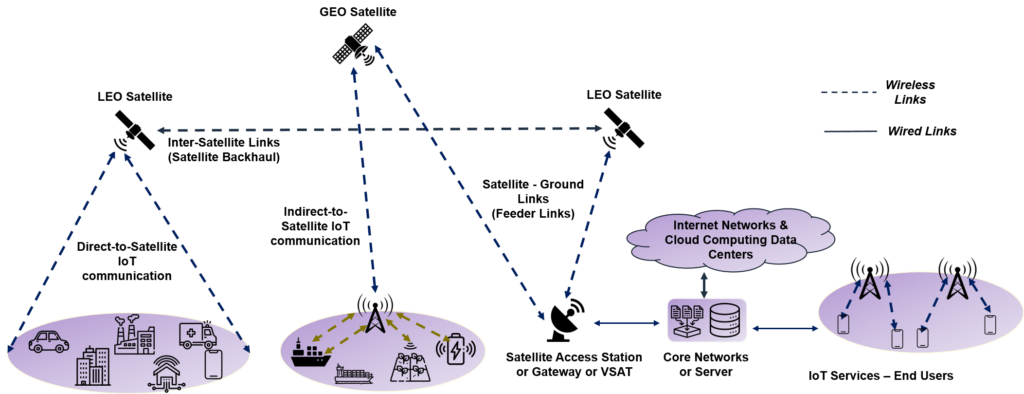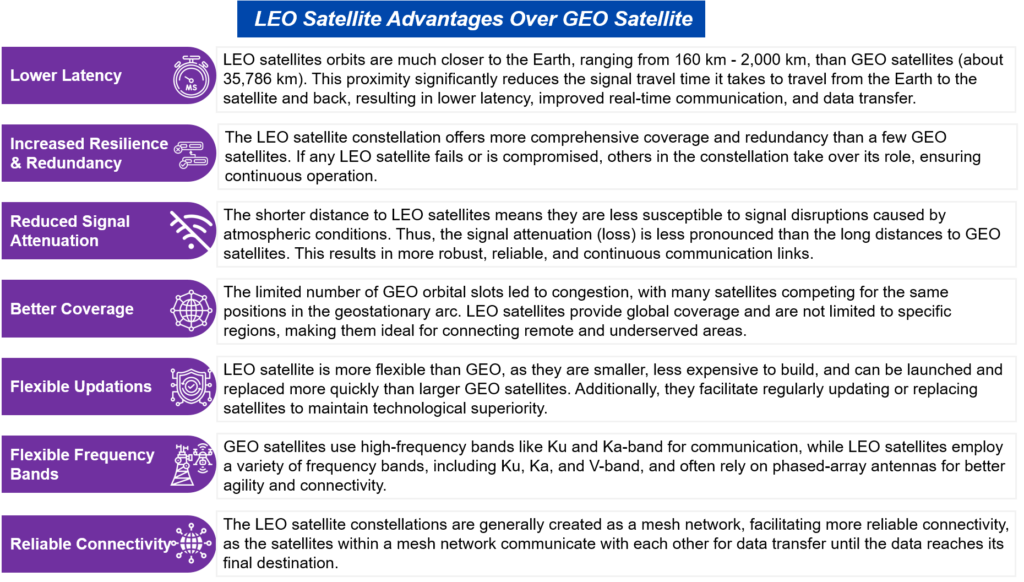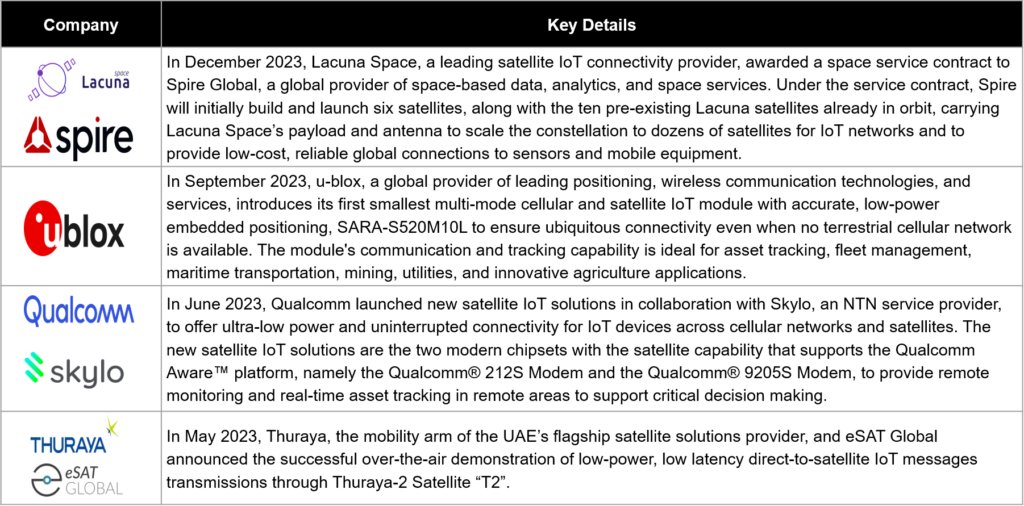The connection of 5G mobile networks and satellite communication, such as 5G Non-terrestrial Networks (NTN), and 5G Advanced promise the promotion of the interconnection of everything as the Internet of Things (IoT) devices continue to grow with other parallel demands, such as higher data rate communication and data services. With the advent of global coverage, connectivity, tracking, monitoring, and managing assets in remote areas, the Space-based Internet of Things (S-IoT) is utilized. Thus, the S-IoT or satellite IoT utilizes satellites to address the terrestrial IoT deployment challenges, such as global coverage, scalability, and connectivity.
This article will explore the S-IoT technology architecture, the need to shift from GEO to LEO, enabling technologies for the space-based IoT, market highlights, the regulatory landscape, and other related aspects.
What is Space-based Internet of Things?
Satellite (space-based) IoT is an IoT service provider that uses satellite communication networks and services to connect terrestrial IoT devices comprising sensors, actuators, and end nodes to a server. It aims to break time and space restrictions for universal intelligent devices in 5G, 5G NTN, or 6G networks.
It allows reliable monitoring, tracking, and managing application connectivity in the industry verticals or industries in remote areas, such as from the maritime market to machine-to-machine (M2M) applications, as well as in agriculture, transportation, oil and gas, utilities, construction, and others. Also, several of the largest heavy equipment Original Equipment Manufacturers (OEMs) in the world rely on satellite IoT devices to monitor and manage deployed assets remotely.
As shown in Figure 1, to enable uninterrupted communication and exchange of data between IoT devices, the architecture of S-IoT involves a complex interplay of various component IoT devices, very small aperture terminal (VSAT), gateways, core networks or servers, satellites, internet networks & cloud computing data centers and end-user devices

Figure 1: Space-based IoT Architecture
How is its Architectural Working?
Firstly, IoT-enabled devices such as sensors, trackers, and monitoring devices should be equipped with satellite communication terminals. It allows the given IoT device to directly connect with a satellite in space, bypassing the need for a complete terrestrial infrastructure.
The IoT device then collects data from its surroundings, such as environmental conditions, equipment performance, or asset tracking. It is then processed and aggregated for transmission via the nearby gateway, such as VSAT, or directly to the satellite using the selected frequencies or routing protocols.
Once received by satellite, this data is relayed back to ground stations such as satellite access stations or VSAT located on Earth, which is then forwarded to the core network or server from where it is again shared with the internet networks and cloud computing data centers for processing, analysis, management, storage and making it accessible to ensure connectivity with cloud services and web gateways. Through the core network or server, the data is also forwarded to the intended recipient, such as farmers, energy operators, or fleet managers, to be processed, analyzed, and visualized through cloud-based or local systems for asset management or remote monitoring.
This architecture is nearly similar to the 5G NTN architecture, as the data processing for transmitting the received data from the satellite occurs at the gateway or core networks. Thus, this architecture enables the efficient functioning of space-based IoT systems, ensuring data collection and communication across large geographic areas for determining wireless access performance, e.g., rate and delay.
Shift from GEO to LEO
The demand for high-speed data connectivity and low-latency transmission is increasing at an unimaginable rate, and so is the need for connectivity platforms to provide higher data throughput, allowing IoT devices of the industrial verticals and organizations to transmit and receive data at higher speeds for real-time monitoring and management. The IoT connectivity through GEO satellites can only fulfill some of the above aspects, as they remain fixed in their position, and providing global coverage becomes limited.
The shifting towards LEO satellite is seen at an increased pace as it provides better IoT connectivity, low latency, scalability, and high-speed internet access. A slight disadvantage is seen in utilizing the LEO satellite, as they are closer to the Earth and cannot provide continuous coverage over a specific area. Thus, the constellations of LEO satellites are utilized to solve the challenge of constant coverage and to reduce satellite failure impact and connectivity loss.
By constantly orbiting the Earth, LEO satellites offer uniform and reliable internet access due to their ability to adapt to changes according to traffic demand patterns, providing aimed coverage where needed most, even in remote areas.
The LEO satellites also expand and evolve by employing advanced technology, such as beamforming, frequency reuse, and phased-array antennas, to increase capacity, reduce latency, and deliver faster and stabilized connections. This enables smart bandwidth allocation and congestion reduction during peak usage hours to ensure that users in rural or remote areas enjoy internet access.
Figure 2 below discloses the key advantages of the LEO satellites that are helping in overcoming the GEO satellite challenges.

Figure 2: LEO Satellite advantages over GEO satellite
What are the key Enabling Technologies for Space-based Internet of Things?
Space-based IoT is driven by various parallel technologies, such as phased antenna arrays, 3D printing, software-defined radios, etc., that are used for satellite IoT connectivity in remote areas. The following are the key technologies shaping the satellite IoT into the future.
Phased Array Antennas:
Phased array antennas in satellite IoT use multiple individual antenna elements that electronically control the antenna beam steering in a specific direction. This flexibility of using the phased array antenna in the satellite allows them to track and communicate efficiently with multiple satellites or ground stations without physically moving the antenna.
For example, ViaSat uses phased array antennas in satellite IoT. The company has established an antenna array that does not rotate physically to track satellites, thus reducing damage to the moving parts and antenna thickness for rapid connectivity delivery.
Software-defined Radios (SDRs):
SDR enables the on-board expansion of the satellite IoT market by allowing the dynamic adjustment of communication parameters, such as frequency, modulation, and protocols, without any physical hardware modifications so that the devices can operate in diverse environments and conditions.
For instance, Saankhya Labs offers innovative SDR-based ground communication systems for various Satcom and Satellite IoT applications. Its solution enables satellite-based real-time tracking of fixed and mobile assets, emergency communication systems, edutainment in remote areas, secure and encrypted defense communication.
3D Printing:
3D printing is increasingly used in space-based internet of things to create custom sensor components for satellites. This technology allows for rapidly developing and deploying specialized satellite IoT in space, thus reducing costs and time to launch new missions.
For example, Fleet Space is a company that uses 3D printing in satellite IoT and has developed a new generation of 3D-printed small satellites called Alpha.
Key Market Highlights for Space-based IoT
As the advancement in space technology continues to grow, the development of the space-based Internet of Things (IoT) is reshaping how we connect and gather data. The following are the key market activities of the space-based IoT.

Conclusion
Space-based IoT provides global coverage, scalability, and connectivity, potentially shaping satellite IoT communication’s future. With the continuous development of IoT device technology, such as reducing component cost and integrating multi-mode modules, the possibility of low-cost satellite connectivity to IoT devices in remote areas seems feasible. However, the satellite IoT connectivity following the 3GPP Rel 17 NTN standard has to be developed for market use. Also, the requirements, such as deploying the constellations, establishing the roaming agreements between cellular and satellite, certifying the satellite chipsets, and managing data security and regulatory challenges, need to be addressed to ensure space-based IoT is safe and effective.